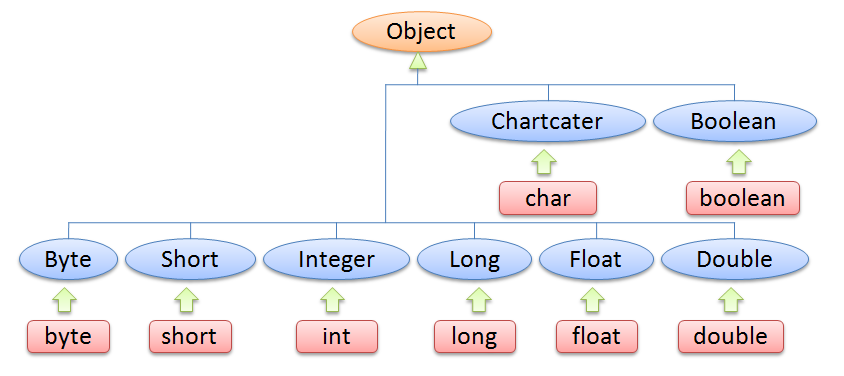在学习并发的过程中,用“Boolean bool = true”的自动装箱方式初始化了两个对象锁去锁两块代码,结果运行的时候出现了竞争等待,调试了一下发现两个锁变量指向的是同一个对象,由此可见我对自动拆装箱的机制想的太简单了,查了一下,发现这个机制还挺细节,那就记录一下:
本文主要有以下几个方面:
- 什么是自动拆装箱
- 拆装箱的实现
- 拆装箱发生的场景
- 关于String
- 回首望月
尝试的第一篇博客,不当之处,求轻喷!
一. 什么是自动拆箱与装箱
我们都知道,Java定义了8种基本类型和与之对应的8中包装器,其中6种数据类型,1种字符类型以及1种布尔类型:

在Java5之前,定义生成一个Integer包装器类型的对象,只能通过以下方式:
- 1 Integer i = new Integer(0);
Java5支持了基本类型和对应的包装类型之前的自动转换机制,即自动拆箱(包装器类型转换成基本类型)与装箱(基本类型封装成包装器类型)。于是,就有了以下两行代码:
- 1 Integer i = 0; //自动装箱
- 2 int j = i; //自动拆箱
二. 自动拆装箱的实现(int-Integer为例)
我们将下面自动拆装箱的代码反编译一下,拆装箱的动作就一目了然。
- 1 public class MainTest {
- 2 public static void main(String[] args) {
- 3 Integer i = 0;
- 4 int j = i;
- 5 }
- 6 }
编译后:

通过反编译的结果看,在"Integer i = 0"自动装箱的过程中,调用了Integer.valueOf(int i)方法;在"int j = i;"的自动装箱的过程中,调用了Integer.intValue()方法。
其中,拆箱方法Integer.intValue()方法很简单:
- 1 /**
- 2 * Returns the value of this {@code Integer} as an
- 3 * {@code int}.
- 4 */
- 5 public int intValue() {
- 6 return value;
- 7 }
只是返回了当前对象的value值,没什么好说的。
但是装箱方法Integer.valueOf(int i)就有细节了,一起看下:
- 1 /**
- 2 * Returns an {@code Integer} instance representing the specified
- 3 * {@code int} value. If a new {@code Integer} instance is not
- 4 * required, this method should generally be used in preference to
- 5 * the constructor {@link #Integer(int)}, as this method is likely
- 6 * to yield significantly better space and time performance by
- 7 * caching frequently requested values.
- 8 *
- 9 * This method will always cache values in the range -128 to 127,
- 10 * inclusive, and may cache other values outside of this range.
- 11 *
- 12 * @param i an {@code int} value.
- 13 * @return an {@code Integer} instance representing {@code i}.
- 14 * @since 1.5
- 15 */
- 16 public static Integer valueOf(int i) {
- 17 if (i >= IntegerCache.low && i <= IntegerCache.high)
- 18 return IntegerCache.cache[i + (-IntegerCache.low)];
- 19 return new Integer(i);
- 20 }
这边的源码比预想的多了一个细节操作,值落在[IntegerCache.low, IntegerCache.high]区间上时,是直接从一个Integer类型的缓存数组IntegerCache.cache中取一个对象返回出去,值不在这个区间时才new一个新对象返回。
看一下IntegerCache的实现,它是Integer类的一个私有静态内部类:
- 1 /**
- 2 * Cache to support the object identity semantics of autoboxing for values between
- 3 * -128 and 127 (inclusive) as required by JLS.
- 4 *
- 5 * The cache is initialized on first usage. The size of the cache
- 6 * may be controlled by the {@code -XX:AutoBoxCacheMax=<size>} option.
- 7 * During VM initialization, java.lang.Integer.IntegerCache.high property
- 8 * may be set and saved in the private system properties in the
- 9 * sun.misc.VM class.
- 10 */
- 11
- 12 private static class IntegerCache {
- 13 static final int low = -128;
- 14 static final int high;
- 15 static final Integer cache[];
- 16
- 17 static {
- 18 // high value may be configured by property
- 19 int h = 127;
- 20 String integerCacheHighPropValue =
- 21 sun.misc.VM.getSavedProperty("java.lang.Integer.IntegerCache.high");
- 22 if (integerCacheHighPropValue != null) {
- 23 try {
- 24 int i = parseInt(integerCacheHighPropValue);
- 25 i = Math.max(i, 127);
- 26 // Maximum array size is Integer.MAX_VALUE
- 27 h = Math.min(i, Integer.MAX_VALUE - (-low) -1);
- 28 } catch( NumberFormatException nfe) {
- 29 // If the property cannot be parsed into an int, ignore it.
- 30 }
- 31 }
- 32 high = h;
- 33
- 34 cache = new Integer[(high - low) + 1];
- 35 int j = low;
- 36 for(int k = 0; k < cache.length; k++)
- 37 cache[k] = new Integer(j++);
- 38
- 39 // range [-128, 127] must be interned (JLS7 5.1.7)
- 40 assert IntegerCache.high >= 127;
- 41 }
- 42
- 43 private IntegerCache() {}
- 44 }
IntegerCache中有3个final类型的变量:
low:-128(一个字节能够表示的最小值);
high:127(一个字节能够表示的最大值),JVM中设置的属性值(通过-XX:AutoBoxCacheMax=设置)二者取大值,再和Integer.MAX_VALUE取小值;
cache:在静态块中初始化为由区间[low, high]上的所有整数组成的升序数组。
综上,Java在虚拟机堆内存中维持了一个缓存池,在装箱的过程中,如果发现目标包装器对象在缓存池中已经存在,就直接取缓存池中的,否则就新建一个对象。
测试一下:
- 1 public static void main(String[] args) {
- 2 Integer i = 127;
- 3 Integer j = 127;
- 4 System.out.println(System.identityHashCode(i)); //本地输出i的地址:1173230247
- 5 System.out.println(System.identityHashCode(j)); //本地输出j的地址:1173230247
- 6
- 7 Integer m = 128;
- 8 Integer n = 128;
- 9 System.out.println(System.identityHashCode(m)); //本地输出m的地址:856419764
- 10 System.out.println(System.identityHashCode(n)); //本地输出n的地址:621009875
- 11 }
由测试结果来看,值为127时,两次装箱返回的是同一个对象,值为128时,两次装箱返回的是不同的对象。
因为小数的区间取值无限,所以float->Float,double->Double两种类型装箱机制没有缓存机制,其他5中基本类型的封装机制也是类似int->Integer的装箱套路,不过缓存的边界不可改变:
| 基本类型 | 包装器类型 | 缓存区间 | 缓存是否可变 |
|---|
| byte |
Byte |
[-128, 127] |
不可变 |
| short |
Short |
[-128, 127] |
不可变 |
| int |
Integer |
[-128, 127] |
上限可设置 |
| long |
Long |
[-128, 127] |
不可变 |
| float |
Float |
-- |
-- |
| double |
Double |
-- |
-- |
| char |
Character |
[0, 127] |
不可变 |
| boolean |
Boolean |
{true, false} |
不可变 |
因为基本类型对应的包装器都是不可变类,多以他们的缓存区间一旦初始化,里面的值就无法再改变,所以在JVM运行过程中,所有的基本类型包装器的缓存池都是不变的。
三. 拆装箱发生的场景
1.定义变量和方法参数传递:
这里的拆装箱是指开发者通过编写代码控制的拆装箱,比较明显:
- 1 public static void main(String[] args) {
- 2 Integer i = 0; //装箱
- 3 int j = i; //拆箱
- 4 aa(i); //拆箱,传值时发生了:int fi = i;
- 5 bb(j); //装箱,传值时发生了:Integer fi = j;
- 6 }
- 7 private static void aa(int fi){
- 8 }
- 9 private static void bb(Integer fi){
- 10 }
2.运算时拆箱
我们都知道,当一个变量的定义类型不是基本类型,其实变量的值是对象的在虚拟机中的地址,当用初始化后的包装器类型变量进行运算时,会发生什么呢?
1.“+,-,*,/ ...”等运算时拆箱
当用包装器类型的数据进行运算时,JAVA会先执行拆箱操作,然后进行运算。
- 1 public class MainTest {
- 2 public static void main(String[] args) {
- 3 Integer i = 127;
- 4 Integer j = 127;
- 5 i = i + j;
- 6 }
- 7 }
将上面一段代码反编译:

发现,除了在分别源码的3,4行进行了装箱操作后,在执行add操作之前,有两次拆箱操作,add之后,又把结果装箱赋值给变量i。
2.“==”判等运算
“==”运算比较特殊:
A == B
- 当A,B都是基本类型时,直接进行比较两个变量的值是否相等
- 当A,B都是包装器类型时,比较两个变量指向的对象所在的地址是否相等
- 当A,B中有一个是基本类型时,会将另一个包装器类型拆箱成基本类型,然后再进行基本类型的判等比较
测试如下:
- 1 public static void main(String[] args) {
- 2 int m = 128;
- 3 int n = 128;
- 4 Integer i = 128;
- 5 Integer j = 128;
- 6 System.out.println(m == n); //输出:true
- 7 System.out.println(m == i); //输出:true
- 8 System.out.println(i == j); //输出:false
- 9 }
前文已经说了,JVM没有设置Integer类型的缓存上限的时候,128不在缓存池内,所以两次封装后的对象是不同的对象。在此基础上:
- 第6行输出true:如果比较的是装箱后的对象地址,结果肯定是false,实际结果是true,说明比较的是基本类型的值,没有发生自动拆装箱动作
- 第7行输出true:如果比较的是装箱后的对象地址,结果肯定是false,实际结果是true,说明比较的是基本类型的值,那么包装器类型的变量肯定进行了自动拆箱动作
- 第8行输出false:如果比较的是拆箱后的基本类型的值,结果肯定是true,实际结果是false,说明比较的是对象的地址,没有发生自动拆装箱动作
看一下反编译的结果:

对应源码中除了第4、5行出现了自动装箱动作,就只有在第7行发生了自动拆箱动作。
四. 关于String类型
String类型没有对应的基本类型,所以没有自动拆装箱的机制,之所以在这里提一下,是因为String的初始化过程和自动装箱的过程很像。
- 1 public static void main(String[] args) {
- 2 String s1 = "hello";
- 3 String s2 = "hello";
- 4 String s3 = new String("hello");
- 5 String s4 = new String("hello");
- 6 System.out.println(System.identityHashCode(s1)); //输出s1地址:1173230247
- 7 System.out.println(System.identityHashCode(s2)); //输出s2地址:1173230247
- 8 System.out.println(System.identityHashCode(s3)); //输出s3地址:856419764
- 9 System.out.println(System.identityHashCode(s4)); //输出s5地址:621009875
- 10 }
从上面的输出结果可以看出,两个直接用字符串赋值的变量s1,s2指向的是同一个对象,而new String()生成对象赋值的变量s3,s4则是不同的对象。
其实,JVM中存在一个字符串缓存池,当直接使用字符串初始化变量的时候,JAVA会先到字符串缓存池中查看有没有相同值的String对象,如果有,直接返回缓存池中的对象;如果没有,就new出一个新的对象存入缓存池,再返回这个对象。而String的不可变性质则能保证在对象共享的过程中不会出现线程安全问题。
与基本类型的缓存池相比,String类型的缓存池在运行时是动态变化的。
五. 回首望月
回到最开始我碰到的问题,当我用“Boolean bool = true”的自动装箱方式定义变量的时候,这两个变量其实指向的都是Boolean类型的缓存池中的那个值为true的对象,所以用他们当做同步锁,其实是用的同一把锁,自然会出现竞争等待。
经验:当我们使用自动装箱机制初始化变量的时候,就相当于告诉JAVA这里需要一个对象,而不是告诉JAVA这里需要一个新的对象。当我们需要一个新的对象的时候,为了保险起见,自己new一个出来,比如锁。